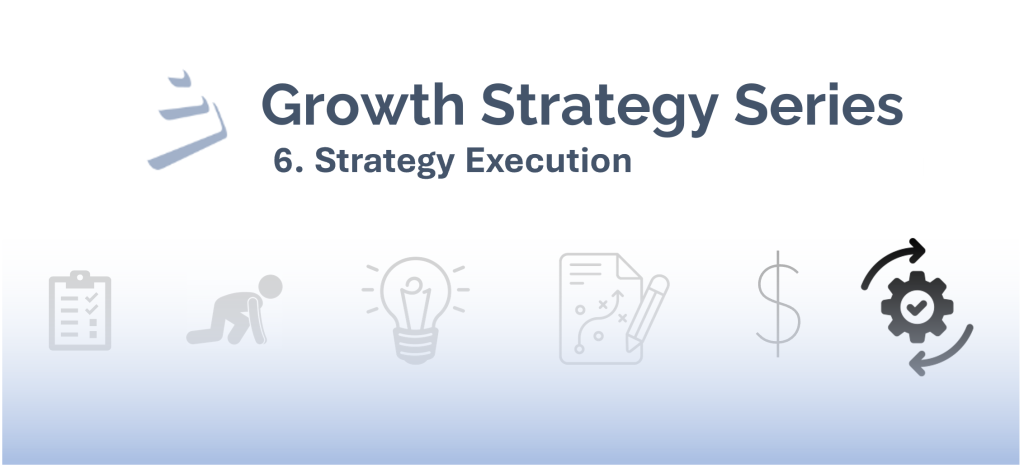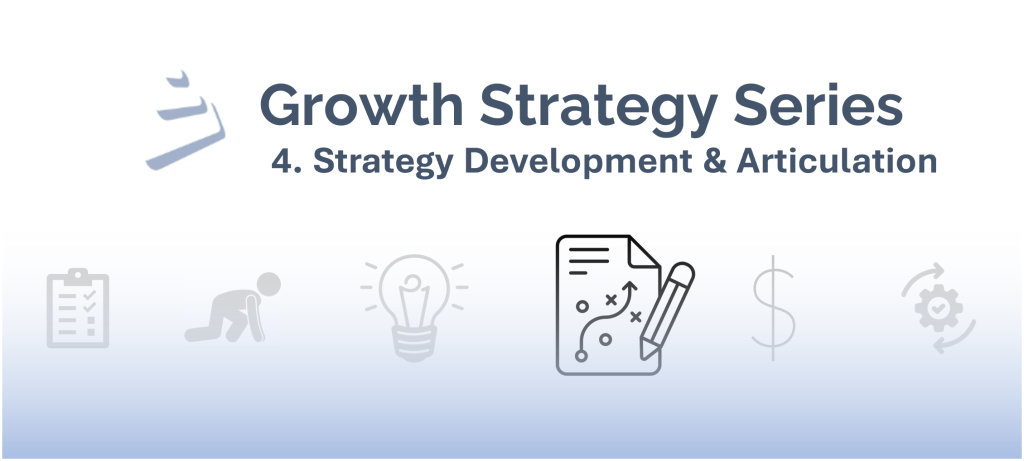Chapter 2 Recap
Welcome back to the Growth Strategy Series. In our last chapter, we discussed mobilization and the strategy readiness phase for growth strategy development – what to expect, who to include, and how to keep people motivated and on-track. Key takeaways are as follows:
- Strategy development is a significant time commitment. Start by assessing existing data and insight – if you already have a strong foundation of internal performance data, market intelligence and analysis, and customer understanding, the timeline can be accelerated considerably.
- Appoint an engaged and motivated project sponsor from your senior leadership team and target a high-potential emerging leader as project lead.
- Core and extended team size and composition may vary from company to company, but your team should include a well-rounded diverse group of leaders and emerging leaders.
- Keep the core and extended teams engaged by communicating the importance of the strategy to the organization’s future, establishing a regular review cadence with the steering committee, and recognizing and rewarding the team for their effort and commitment.
In this chapter, we will outline the insights generation process, including market, competitive, customer, and business performance assessments.

Chapter 3: Insights Generation
Introduction to Insights Generation
We strongly believe the core of any sound strategy is deep, proprietary insight uncovered through thorough research and analysis. True insights go beyond facts, figures, and observations; they are data-backed “a-ha” discoveries that (re-)define how you view your business landscape, and often arrived at through the careful analysis and synthesis of various findings. Their proprietary nature provides a competitive advantage while establishing a “single source of truth” across the organization, and it is these insights that serve as the foundation from which to make strategic choices. Generating insights for your business often presents an opportunity to challenge internal narratives, so expect to tackle difficult questions with significant implications for your business and team.
Generate Your Insights
We typically split the insights generation phase into four simultaneous workstreams completed over 2 – 4 months: market assessment, customer assessment, competitive assessment, and business performance analysis (as discussed in our last chapter, timeline will be largely dependent on the quality of existing insights). Each workstream may be managed by separate project teams and leverage different subject matter experts within the organization, but these workstreams need to ultimately come together as one cohesive narrative for the business. And while unique workstreams can produce insights individually, it is the synthesis of the four workstreams that most often yields true insight.
- The Market Assessment evaluates the external landscape, including market and industry size, growth rates, market shares, potential disruptors, and other trends and drivers. Cuts by geography, product line, channel, and/or addressable market allow for a more detailed and nuanced view of the landscape too. Market assessments employ a variety of qualitative and quantitative data sources including market reports, expert interviews, internal estimates, commercial datasets, trade statistics, and surveys, the results of which offer insight as to whether future market growth will support your growth aspirations or if there are significant concerns or risks in the market landscape going forward. Conducting market assessment work outside of core markets can also help to identify adjacent markets in which to play.
- The Customer Assessment establishes a baseline for how to segment and win with your target customers and/or consumers, while identifying key perceptions (strengths and weaknesses) that your customers, and potential customers, have about you. Customer information is typically solicited through customer interviews and/or a quantitative survey aimed at understanding awareness, customer satisfaction, preferences, and drivers of purchasing behavior, and perceived differences among the competitive set. Customer feedback is critical when building a growth strategy, as we commonly find customers perceive their partners and suppliers much differently than the partners and suppliers perceive themselves. A deep understanding of customers can also help inform which customers to target (and not target) and ensures that future offers, capabilities, and positioning are meaningful, valuable and aligned to customer needs and preferences.
- The Competitive Assessment complements the market and customer assessments by providing an understanding of the competitive landscape and your company’s relative positioning. Related activities, including competitive profiling, positioning analysis, and offer research, often utilize secondary sources, surveys, and expert interviews. Competitive assessments can also include, but are not limited to, relative sizes and market shares, margin profiles, brand positioning, M&A landscape (general activity, potential threats, potential acquisitions), and competitors in adjacent categories. Given that competitive research is arduous and competitor data can be limited (especially for privately held companies), we recommend defining the core and adjacent competitive sets before diving too far into research. Core competitors demand attention and detailed research while the focus for adjacent competitors should be on identifying major opportunities, threats, and disruptors.
- The Business Performance Analysis determines where and how your company is making money. The aim of the business performance analysis is typically to determine revenue and profitability (ideally at the EBITDA-level) by the most relevant intersections of the business as is feasible: business unit, geography, end-market, site, customer, and additional breakdowns as necessary. This analysis provides an aligned, single view of company performance and the financial underpinning upon which to build a quantified growth plan. Interestingly, this is often an eye-opening exercise for many companies as various record-keeping systems, cost allocation methods, internal biases, and a lack of detailed data can lead to blind spots and a misunderstanding of company profitability. Depending on your industry, we also recommend a high-level operational assessment as part of the business performance analysis to develop a baseline understanding of where products or services are produced, what operational challenges exist, and what existing initiatives are in place to drive operational improvement.
Additional Guidance
Whether due to data limitations, methodological constraints, prohibitive costs, or lack of resources, you may need to accept some uncertainty during insights generation. There will likely be cases where managerial judgment is required to make informed choices about your market, competitors, customers, and business to reach the finish line. We recommend the following for a successful insights generation phase:
- Keep an Open Mind: Avoid falling back on existing views of your external and internal landscape if the data suggests otherwise. Remain open-minded and let the data and research lead you.
- Ensure Ongoing Alignment: Bring the organization along with you during insights generation, especially key stakeholders. Do not wait until the end to get alignment on your findings, especially those that are counter to conventional wisdom.
- Build in Flexibility: Make models dynamic and flexible enough to allow for frequent updates and assumption changes as markets continue to evolve and understanding of market dynamics continues to improve. These should be tools that can be utilized long after the strategy is established.
- Make It Repeatable: Look to utilize processes and inputs that can be refreshed and adopted long-term. Questionnaires, models, research methodologies should not only be ad hoc approaches.
- Stay Strategic: While challenging, as many have the urge to address identified issues and opportunities immediately, save tactical discussions and analysis for later stages of the strategy development process once you have all your insights and inputs defined.
Finally, remember that data and insights do not make decisions, people do. At the end of insights generation, you will have a tremendous amount of data and inputs; it is up to you to translate those into the most salient insights to drive your strategy (to be discussed in our next chapter!).
Takeaways and What’s Next
In this chapter, we covered the second stage of our growth strategy process, insights generation, which takes place across four distinct workstreams. Key takeaways include…
- Insights are not findings and observations. They are the result of careful analysis and often a combination and synthesis of various facts and data points.
- The insights generated via the analysis and research related to the market, customer, and competitive assessments, along with the business performance analysis will ultimately form the foundational knowledge and single source of truth upon which you will build your strategy.
- To navigate inevitable disagreement and avoid common pitfalls, be open to change, internalize the impact of your assumptions, develop repeatable and scalable processes and tools, and save tactical discussions for later in the strategic process.

In our next chapter, we will outline how to transform insights into a fully articulated growth strategy. For questions about this piece, coming installments, or how we can help at any stage of strategy development, contact Mike Gill, Senior Consultant, or Pieter Rhynhart, Associate Consultant at Denneen & Company.
Denneen & Company is a growth strategy consulting firm that has been helping companies find and follow their unique paths to growth for over 29 years. With experience across 20+ industries, 40+ consumer categories, and 40+ countries, Denneen & Company consultants leverage their former backgrounds as industry practitioners and past engagements to develop practical and achievable strategies based on rigorous analysis, breakthrough insights, and a collaborative approach. To learn more, please visit denneen.com.


